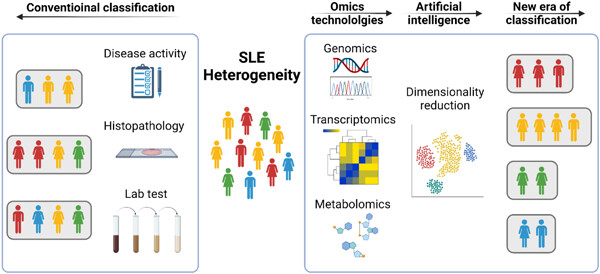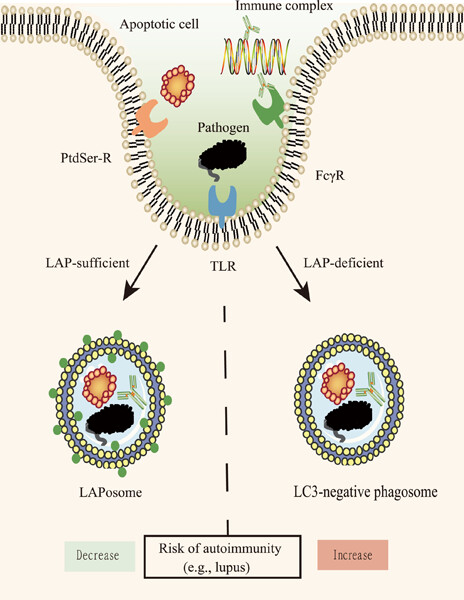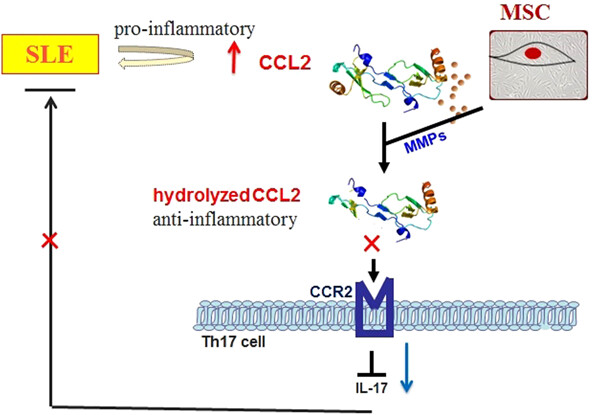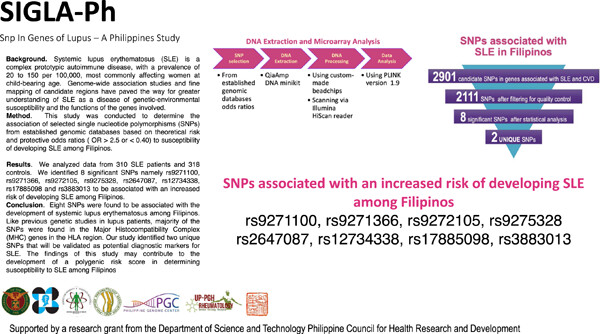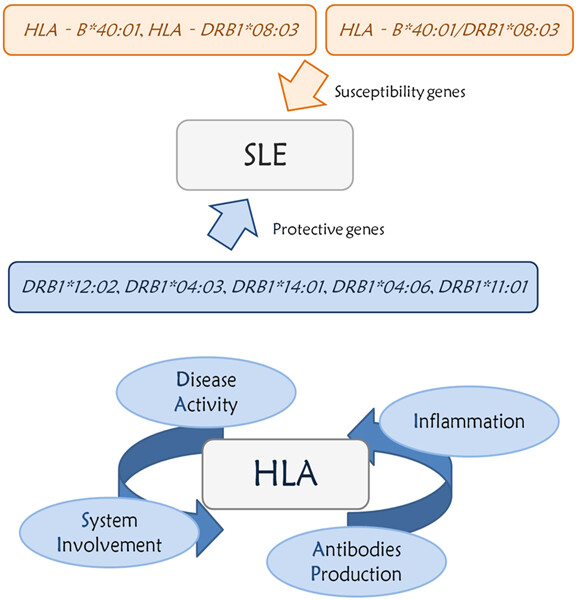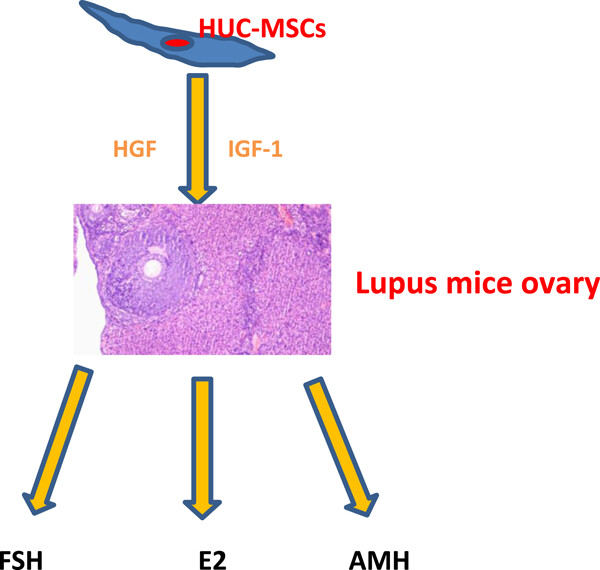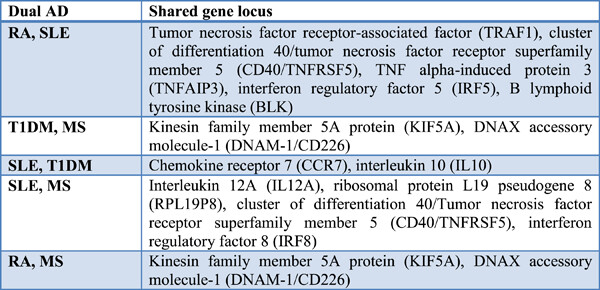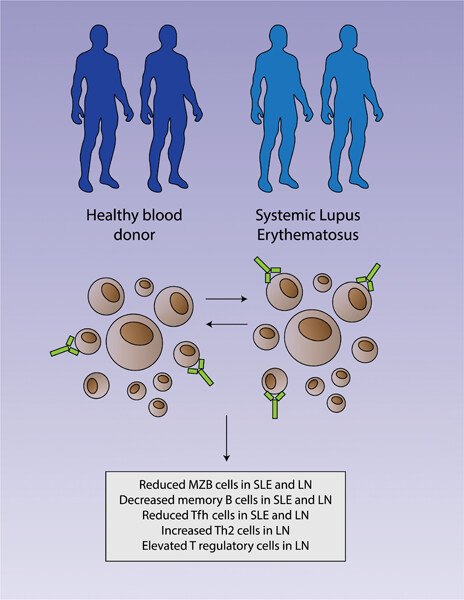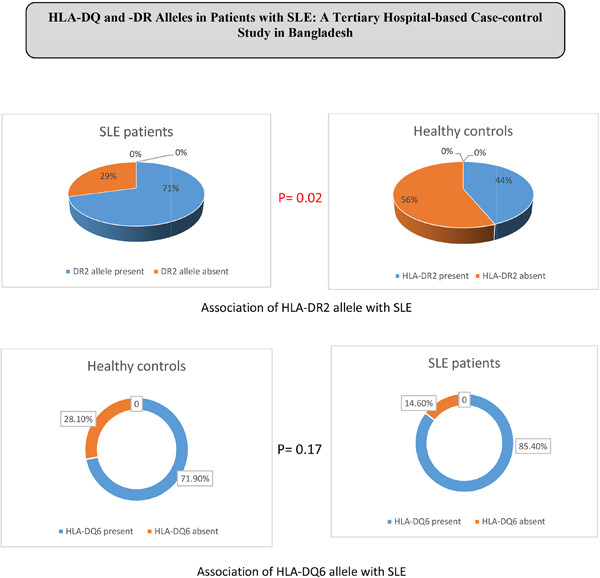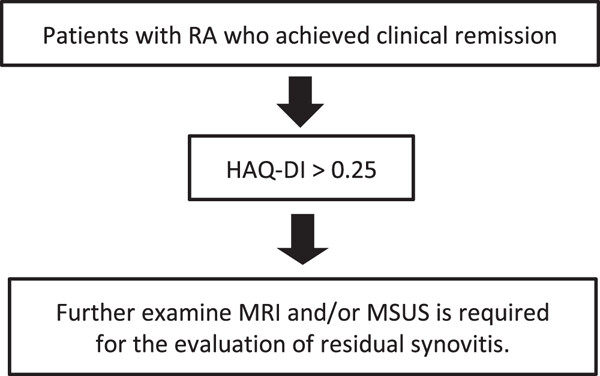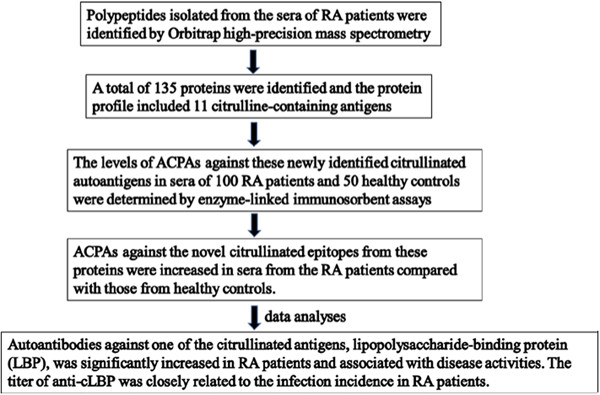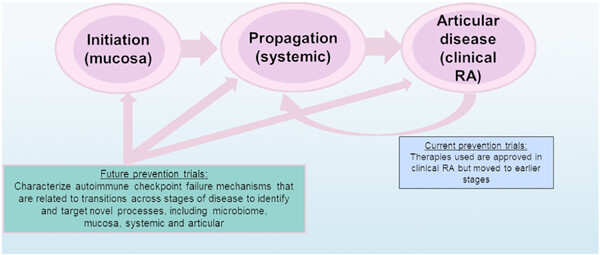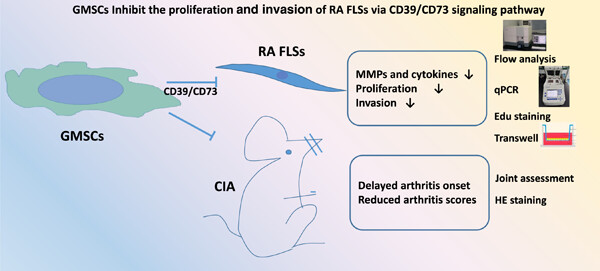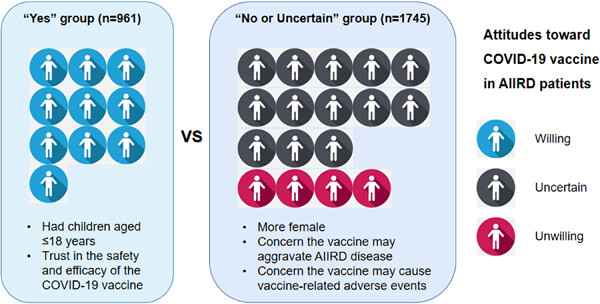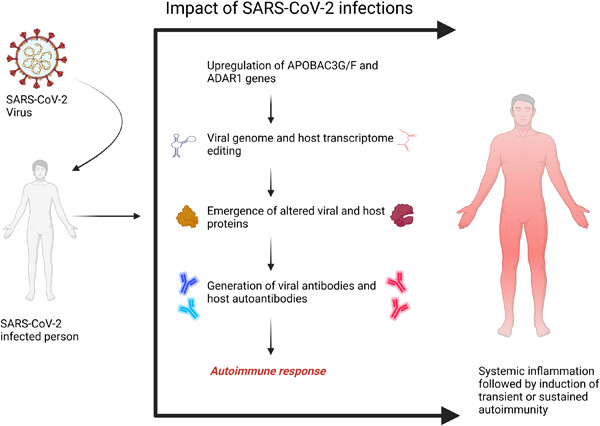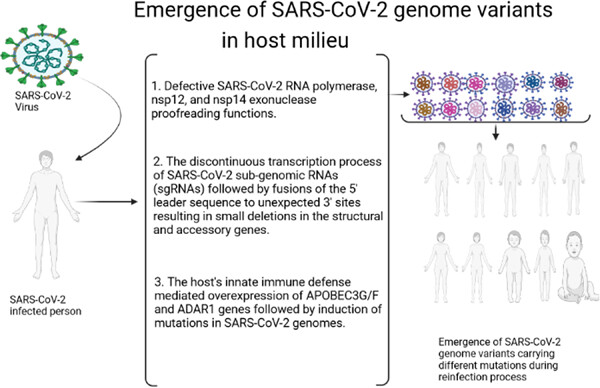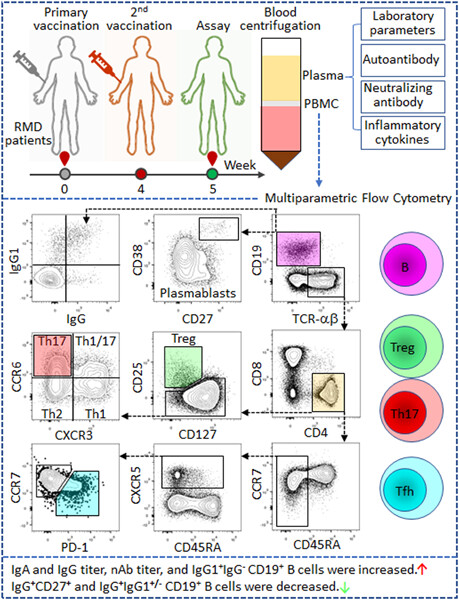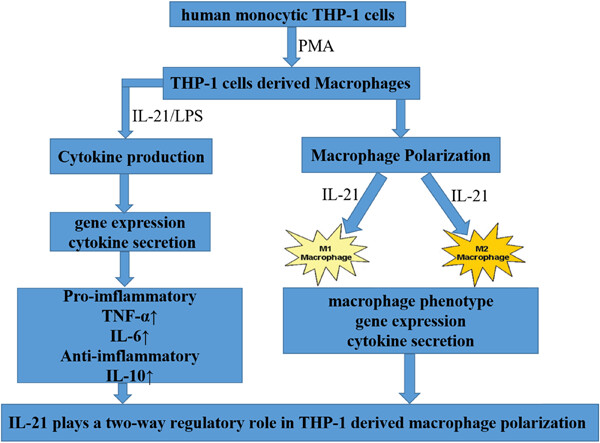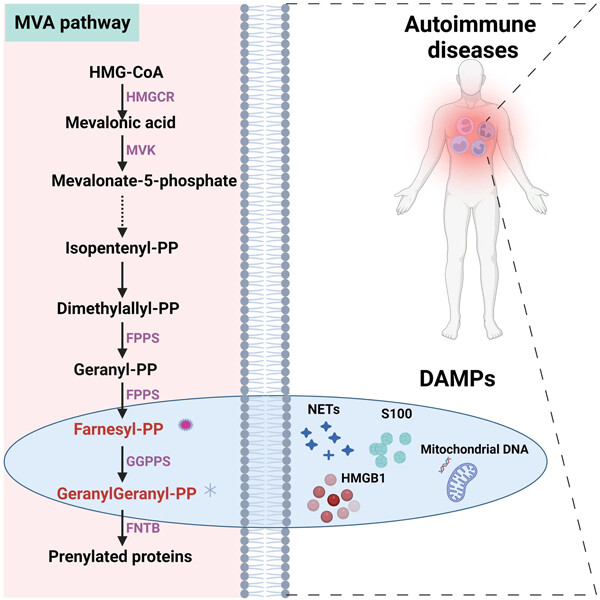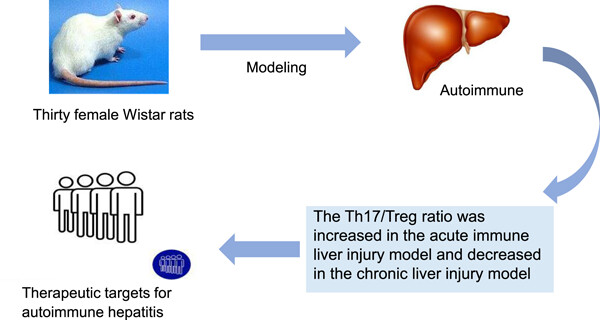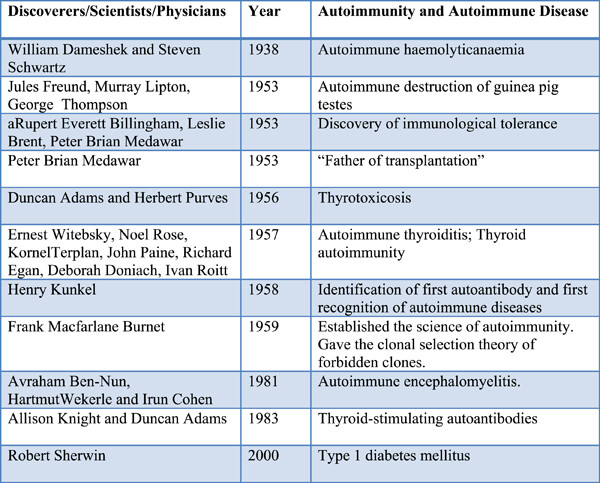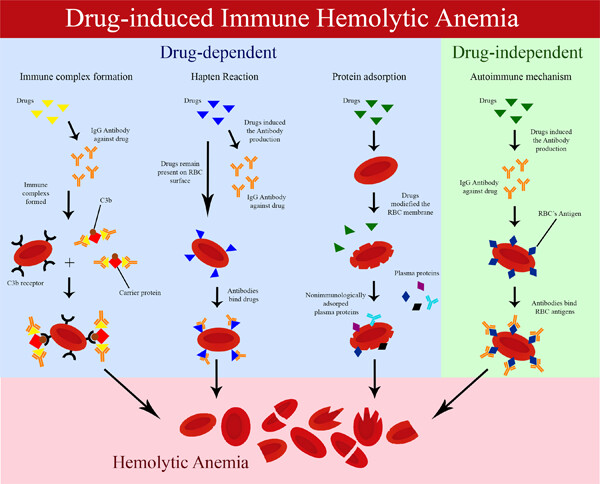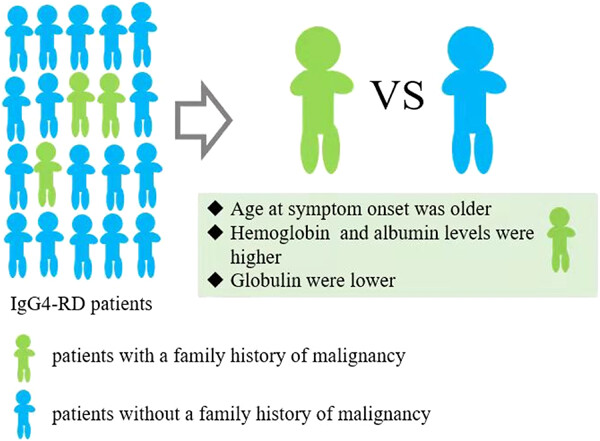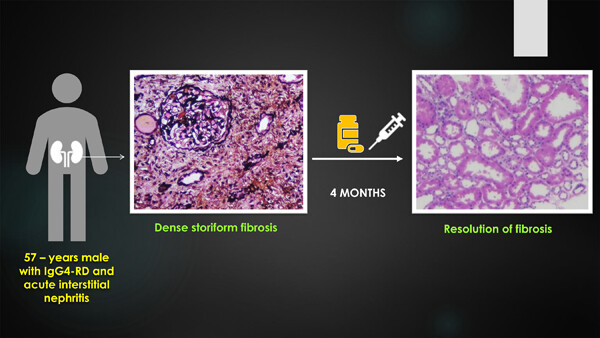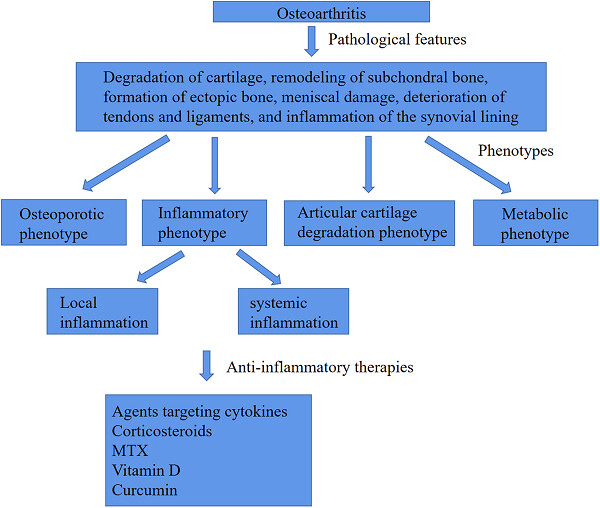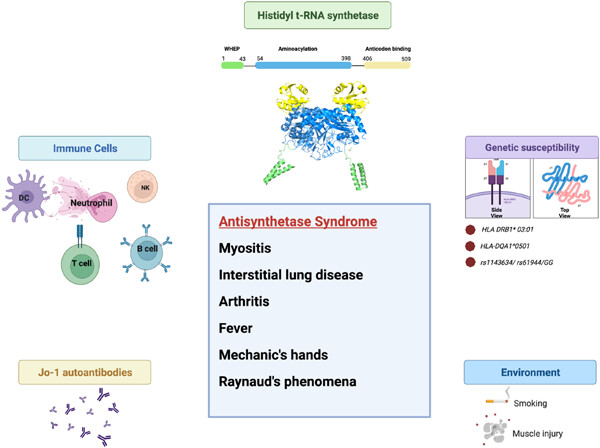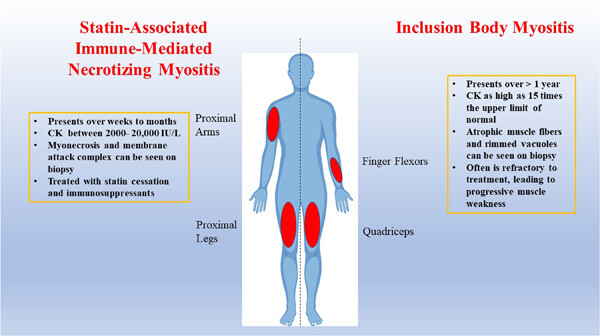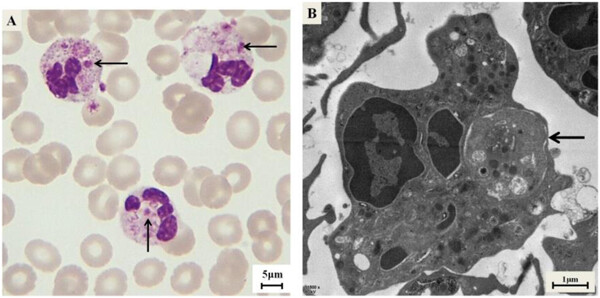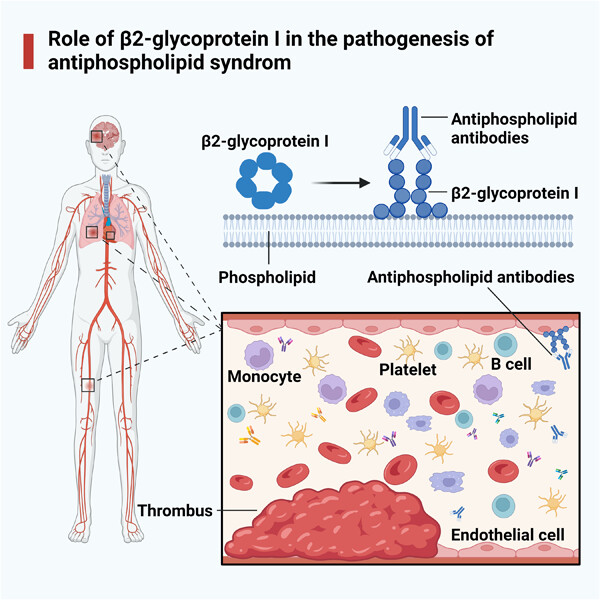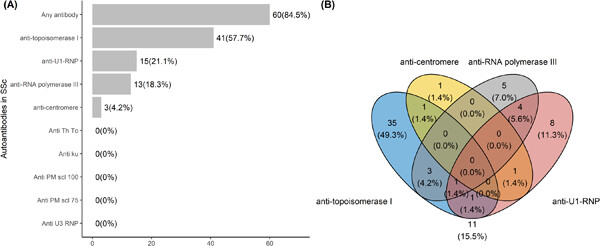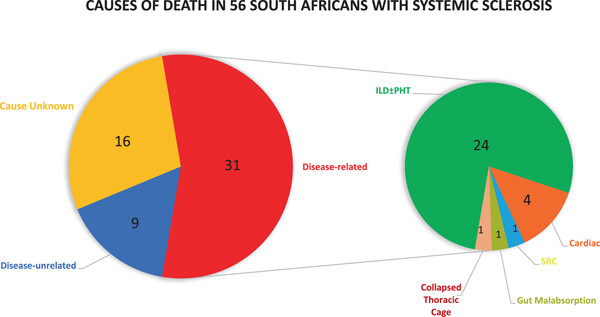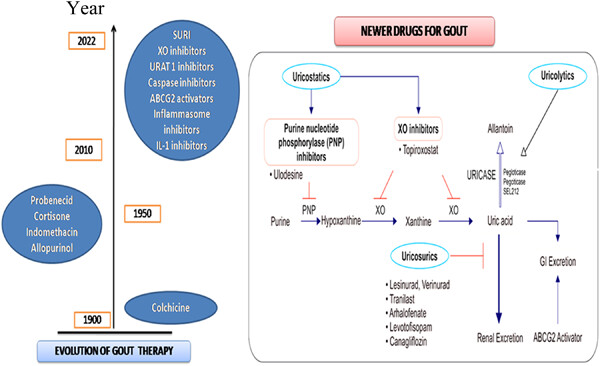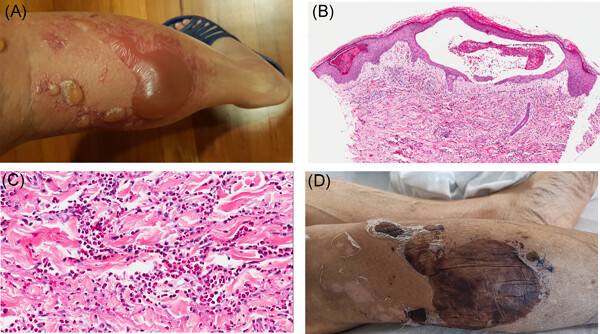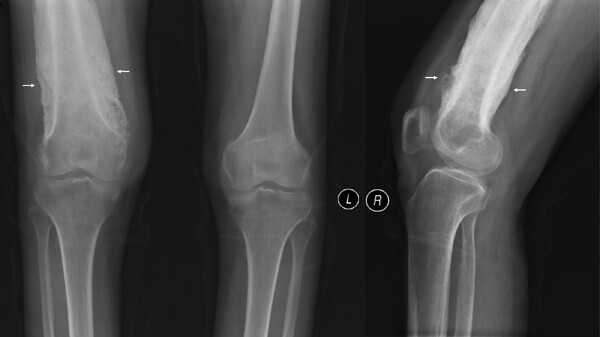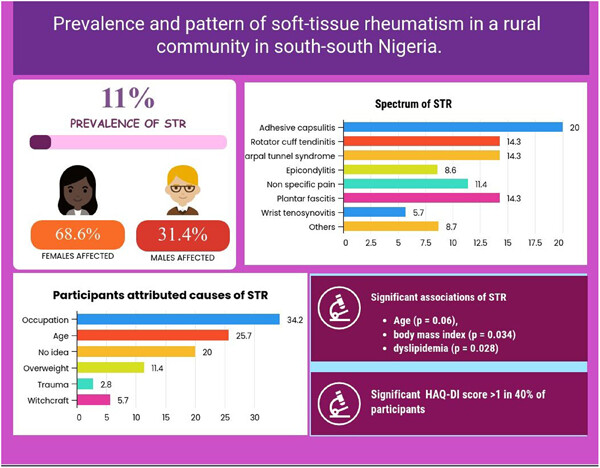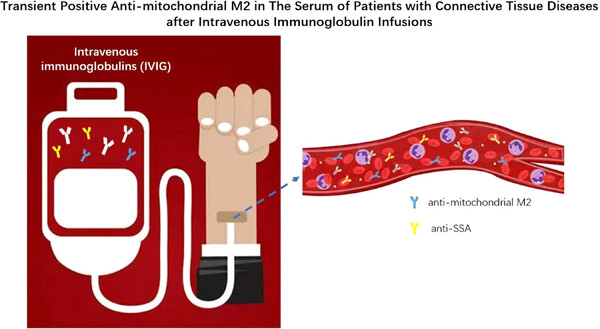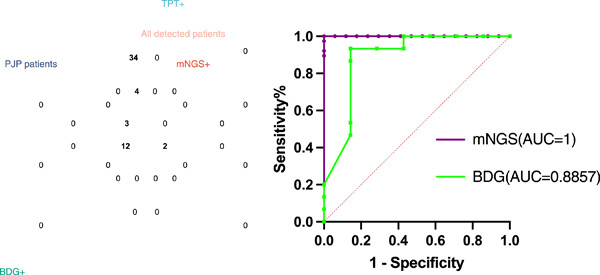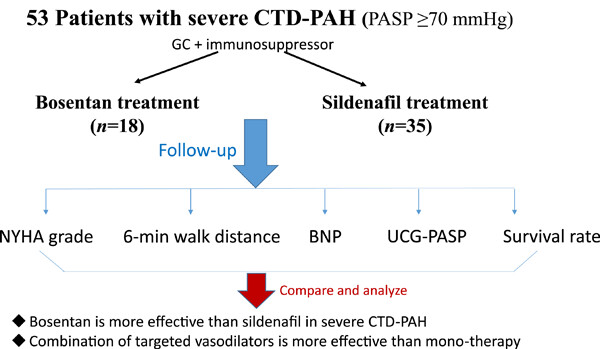Journal list menu
- Open access
Noncanonical autophagy in systemic lupus erythematosus
Key points
-
Accumalating evidence supports that autophagy plays a pivotal role in pathogenesis of SLE.
-
Noncanonical autophagy pathways which do not critically rely on all core ATG proteins to form functional autophagosomes, also have been discovered in SLE.
-
Genome-wide association studies linking polymorphisms in key genes of LC3-associated phagocytosis (LAP), such as NCF1 and NCF2, with an increased susceptibility to SLE.
-
LAP dysfunction or dysregulation may result in defective processing and degradation of dead cells, overproduction of inflammatory cytokines and type I Interferon in SLE.
Open accessMSCs relieve SLE by modulation of Th17 cells through MMPs–CCL2–CCR2–IL‐17 pathway
Highlights
-
CCL2 activates Th17 to participate in SLE.
-
UC-MSCs secret MMPs to hydrolyze CCL2.
-
Hydrolyzed CCL2 inhibit Th17 to relieve SLE.
Open accessIdentification and functional analysis of shared gene signatures between systemic lupus erythematosus and Sjögren's syndrome
Graphical Abstract
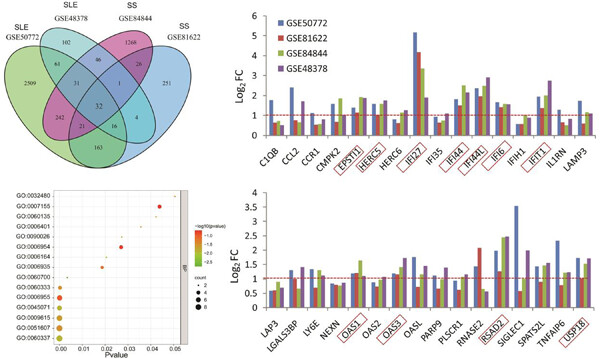
Thirty-two shared differential expressed genes (DEGs) were screened in systemic lupus erythematosus and Sjögren's syndrome transcriptome data sets. These 32 shared DEGs were mainly enrichment in biological progress associated with type I interferon signaling pathway, defense response to virus, response to virus, negative regulation of viral genome replication, and immune response.
Key points
-
Two hundred and thirty-two and 110 differentially expressed genes (DEGs) were screened in systemic lupus erythematosus (SLE) and primary Sjögren's syndrome (pSS) peripheral blood mononuclear cells RNA-seq data sets, respectively.
-
Thirty-two shared DEGs were screened in SLE and pSS data sets, which were all upregulated in patients compared to controls.
-
These 32 shared DEGs were mainly enrichment in biological progress associated with type I interferon signaling pathway, defense response to virus, response to virus, negative regulation of viral genome replication, and immune response.
Open accessSingle nucleotide polymorphism (SNP) in genes of lupus: A Philippine study (SIGLA‐PH)
Michael L. Tee, Cherica A. Tee, Jose B. Nevado, Angeline Therese Santiago, Aedrian A. Abrilla, Carlo M. Lapid, Francis A. Tablizo, Joshua A. Dizon, El K. B. Morado, Eva Maria Cutiongco-Dela Paz,Graphical Abstract
Key points
-
Eight SNPs, namely rs9271100, rs9271366, rs9272105, rs9275328, rs2647087, rs12734338, rs17885098, and rs3883013, were found to be associated with an increased risk of developing SLE among Filipinos.
Open accessAssociation between HLA-B and HLA-DRB1 polymorphisms and systemic lupus erythematosus in Han population in China
Xiangyu Wang, Yifan Yang, Bibhuti Upreti, Shuang Liu, Ruomei Cui, Yuqi Cheng, Li Tao, Jing Dong, Luqiong Li, Jian Xu,Graphical Abstract
Key points
-
SLE in Han population in Yunnan province was associated with several alleles in HLA-B and HLA-DRB1 loci.
-
Some alleles were associated with inflammation, immune disorders, and organ involvement in SLE.
Open accesslncRNA X-inactive-specific transcript is a potential biomarker related to changes in CD4+ T cell levels in systemic lupus erythematosus
Graphical Abstract
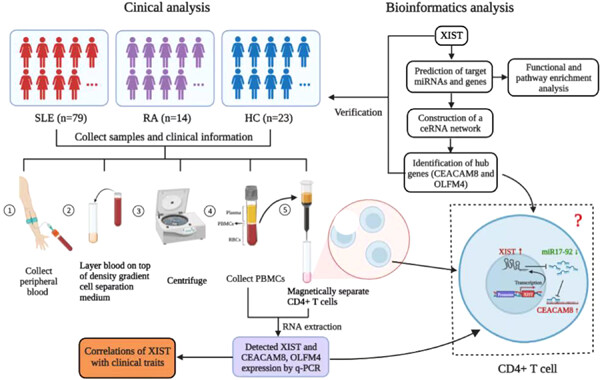
Seventy-nine SLE patients, 14 RA patients, and 23 healthy controls were recruited for this study to determine XIST expression in PBMCs and CD4+ T cells. Then, correlations of XIST with clinical traits in SLE patients were performed to understand the biological function of XIST. Bioinformatics methods, including prediction of target miRNAs and genes, construction of a ceRNA network, and functional and pathway enrichment analysis, were used to explore the function and regulatory mechanism of XIST. Finally, we found that XIST may play a biological role in SLE by regulating the miR-17-92 cluster and CEACAM8 in CD4+ T cells. ceRNA, competitive endogenous RNA; PBMCs, peripheral blood mononuclear cells; RA, rheumatoid arthritis; SLE, systemic lupus erythematosus; XIST, X-inactive-specific transcript.
Key points
-
X-inactive-specific transcript (XIST) was significantly elevated in peripheral blood mononuclear cells (PBMCs) and CD4+ T cells from systemic lupus erythematosus (SLE) patients and has potential diagnostic and therapeutic value for SLE.
-
XIST may play a biological role in SLE by regulating the miR-17-92–CEACAM8 axis in CD4+ T cells.
Open accessEffect of human umbilical cord mesenchymal stem cells on ovarian function in lupus mice
Graphical Abstract
Key points
-
Ovarian function in lupus mice was abnormal with disturbed hormone secretion and folliculogenesis and human umbilical cord mesenchymal stem cell transplantation could recover ovarian function in lupus mice.
-
Systemic lupus erythematosus (SLE) itself may have an abnormal ovarian function. We also suggested novel strategies to treat patients with SLE with premature ovarian failure.
Open accessDual autoimmune diseases: Rheumatoid arthritis with systemic lupus erythematosus and Type 1 diabetes mellitus with multiple sclerosis
Key points
-
Autoimmune diseases (ADs) can be classified into organ-specific or nonorgan-specific, that is, tissue specificity (e.g., thyroid in Hashimoto's thyroiditis) or against widely expressed antigens (e.g., nuclear antigens in systemic lupus erythematosus [SLE]).
-
SLE is distinguished by the presence of circulating autoantibodies and immune complex deposition, both of which can induce inflammatory damage to the organs.
-
Rheumatoid arthritis (RA), also known as inflammatory arthritis, is a systemic AD that affects the joints and causes synovitis.
-
Multiple sclerosis (MS) is a central nervous system inflammatory disease with various neurological and autoimmune symptoms.
-
Familial inheritance and genetic links have been reported between RA and SLE, and Type 1 diabetes mellitus and MS.
-
Identification of shared major genes and biological pathways would be useful as a potential therapeutic targets and biomarkers in dual ADs.
Open accessImmunophenotyping identifies distinct cellular signatures for systemic lupus erythematosus and lupus nephritis
Yi Tong V. Aw, Phillip J. Whiley, Ayla May Lorenzo, Tom Lea-Henry, Somasundhari Shanmuganandam, Maurice Stanley, Sonia N. Babu, Vicki Athanasopoulos, Jean Cappello, Julia I. Ellyard, Matthew Cook, Carola Vinuesa, Giles Walters, David A. Fulcher, Simon H. Jiang,Graphical Abstract
Key points
-
Patients with SLE had reduced marginal zone B cells, memory B cells and circulating T follicular helper cells compared to healthy blood donors.
-
Patients with lupus nephritis had increased Th2 and T regulatory cells compared to SLE patients without lupus nephritis and healthy blood donors.
Open accessHLA‐DQ and ‐DR alleles in patients with SLE: A tertiary hospital‐based case–control study in Bangladesh
Muhammad S. A. Khan, Shamim Ahmed, Iftekhar H. Bandhan, Farhana Zaman, Md. Kamrul H. Sajib, Shirin Tarafder, Minhaj R. Choudhury, Syed A. Haq, Mohammad M. Zaman,Graphical Abstract
Key points
-
HLA-DR2 allele was found in patients with SLE in significantly higher frequency than the healthy Bangladeshi adults.
-
HLA-DQ6 allele was found to have a significant association with mucocutaneous manifestations of the cases.
-
The first study in Bangladesh with HLA-DQ alleles in patients with SLE.
-
Limitations: Single tertiary level hospital-based study and small sample size.
Open accessBelimumab shows promise in neuropsychiatric lupus: Another challenge to find the offender
Graphical Abstract
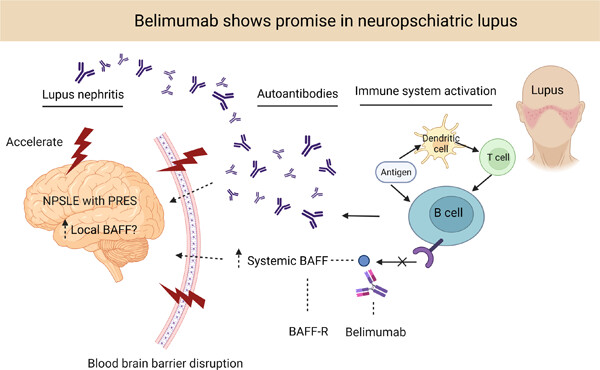
Belimumab shows promise in neuropsychiatric lupus. Posterior reversible encephalopathy syndrome (PRES) frequently occurs during active systemic lupus erythematosus (SLE). The nephrotic state is a unique risk for PRES. Therapy of belimumab could promote the normalization of serologic activity and reduce BAFF-dependent B-cell subsets in serologically and clinically active SLE. BAFF, B-cell activating factor; BAFF-R, BAFF-receptor; NPSLE: Neuropsychiatric SLE.
Key points
-
The nephrotic state is a specific risk factor for posterior reversible encephalopathy syndrome (PRES) in patients with lupus renal flares.
-
Belimumab showed efficacy and safety in a lupus nephritis patient with PRES.
Open accessMesenchymal stem cell transplantation as a potential therapy for refractory lupus nephritis: A systematic review
Faisal Parlindungan, Johanda Damanik, Abirianty P. Araminta, Ariel V. Soetedjo, Rudy Hidayat, Suryo A. Kusumo Wibowo, Anna Arianne, Sumariyono Sumariyono,Graphical Abstract
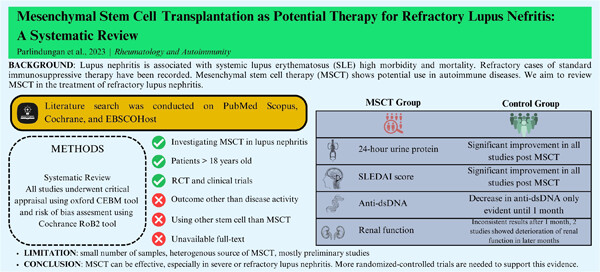
Mesenchymal stem cell transplantation (MSCT) showed improvement in 24-h urine protein and Systemic Lupus Erythematosus Disease Activity Index score when compared with standard treatment in severe or refractory lupus nephritis (LN). This systematic review showed that MSCT has a potential role for the treatment of refractory or severe LN and more studies to clarify this role needed to be done in the future.
Key points
-
Refractory lupus nephritis (LN) has been an emerging problem associated with high morbidity and mortality, in conjunction with the limitation of novel treatment discovery.
-
Mesenchymal stem cell transplantation (MSCT) has been shown to be effective in several autoimmune and rheumatic diseases, hence it is hypothesized to play a role in LN.
-
In this systematic review, MSCT showed improvement in 24-h urine protein and Systemic Lupus Erythematosus Disease Activity Index score when compared with the standard treatment but showed inconsistent results in renal function and anti-dsDNA titers.
-
MSCT can potentially be a selected treatment for refractory LN, but further randomized-controlled trials are needed to clarify its role in LN treatment.
-
- Open access
Subclinical synovitis detected by magnetic resonance imaging and ultrasonography following clinical remission in patients with rheumatoid arthritis: A retrospective study
Masao Nawata, Kazuki Someya, Takafumi Aritomi, Masashi Funada, Katsumi Nakamura, Kazuyoshi Saito, Yoshiya Tanaka,Graphical Abstract
Key points
-
Significant findings of the study: This study evaluated subjective residual symptoms and imaging findings using musculoskeletal ultrasound and magnetic resonance imaging in patients with rheumatoid arthritis (RA) who achieved clinical remission.
-
What this study adds: A Health Assessment Questionnaire Disability Index score of ≤0.25 may indicate reduced severity of residual synovitis in patients with RA following clinical remission.
Open accessIdentification of lipopolysaccharide‐binding protein as a novel citrullinated autoantigen in rheumatoid arthritis
Xiaozhen Zhao, Yuling Chen, Wen Wen, Yongjing Cheng, Ru Li, Xu Liu, Yuhui Li, Rulin Jia, Haiteng Deng, Zhanguo Li, Xiaolin Sun,Graphical Abstract
Highlights
-
Serum protein analysis by high-precision proteomic technology is a feasible method to identify novel citrullinated epitopes in RA patients.
-
Anti-cLBP antibodies are associated with disease severity and infection in RA patients.
Open accessTocilizumab in rheumatoid arthritis‐associated peripheral ulcerative keratitis: A 1‐year follow‐up case report
Graphical Abstract
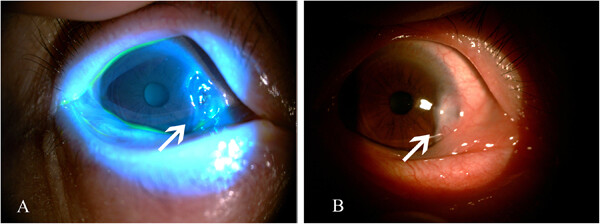
(A) An invasive ulcer presented in nasal limbus with perforation and iris prolapse at 9 o'clock in the right eye of a 64-year-old female with rheumatoid arthritis. (B) Seven months after the treatment with tocilizumab. Corneal pannus completely covers the ulcer surface. The central depth of the anterior chamber was 4ct, anterior synechia, normal fundus.
Key points
-
Peripheral ulcerative keratitis is a rare complication in patients with rheumatoid arthritis and it may cause a marked decrease of visual acuity or the loss of an eye.
-
Tocilizumab may be an additional tool for patients with rheumatoid arthritis-associated peripheral ulcerative keratitis that is refractory to other drugs.
Open accessThe comprehensive geriatric assessment of an older adult with rheumatoid arthritis
Key point
-
Our mainly point is focusing on assessing EROA patients' status with CGA and we treated patient by following the results of CGA.
Open accessMechanism‐driven strategies for prevention of rheumatoid arthritis
V. Michael Holers, Kristine A. Kuhn, M. Kristen Demoruelle, Jill M. Norris, Gary S. Firestein, Eddie A. James, William H. Robinson, Jane H. Buckner, Kevin D. Deane,Graphical Abstract
Key points
Significant findings of the study:
-
Seropositive rheumatoid arthritis (RA) evolves over years before the development of clinically apparent inflammatory arthritis.
-
Emerging data support a model wherein mucosal inflammation precedes the development of systemic autoimmunity, followed by the development of synovitis.
-
The development of RA may entail multiple “endotypes” across individuals who ultimately develop clinical disease.
What this study adds:
-
Mechanisms that should normally constrain RA-related autoimmunity at specific checkpoints, including mucosal and systemic processes that limit autoimmunity, appear to fail during the preclinical development of RA.
-
By understanding and targeting these failed mechanisms, it may be possible to prevent, or minimally ameliorate, the development of classified RA.
Open accessDual autoimmune diseases: Rheumatoid arthritis with systemic lupus erythematosus and Type 1 diabetes mellitus with multiple sclerosis
Key points
-
Autoimmune diseases (ADs) can be classified into organ-specific or nonorgan-specific, that is, tissue specificity (e.g., thyroid in Hashimoto's thyroiditis) or against widely expressed antigens (e.g., nuclear antigens in systemic lupus erythematosus [SLE]).
-
SLE is distinguished by the presence of circulating autoantibodies and immune complex deposition, both of which can induce inflammatory damage to the organs.
-
Rheumatoid arthritis (RA), also known as inflammatory arthritis, is a systemic AD that affects the joints and causes synovitis.
-
Multiple sclerosis (MS) is a central nervous system inflammatory disease with various neurological and autoimmune symptoms.
-
Familial inheritance and genetic links have been reported between RA and SLE, and Type 1 diabetes mellitus and MS.
-
Identification of shared major genes and biological pathways would be useful as a potential therapeutic targets and biomarkers in dual ADs.
Open accessHuman gingival tissue‐derived mesenchymal stem cells inhibit proliferation and invasion of rheumatoid fibroblast‐like synoviocytes via the CD39/CD73 signaling pathway
Graphical Abstract
Key points
-
Gingiva-derived mesenchymal stem cells (GMSCs) suppress the proliferation and invasion of rheumatoid arthritis fibroblast-like synoviocytes (RA FLSs) from RA patients.
-
GMSCs are effective in treating experimental arthritis.
-
- Open access
The COVID‐19 vaccine: Attitudes and vaccination in patients with autoimmune inflammatory rheumatic diseases
Graphical Abstract
Key points
-
The percentage of patients willing to receive the COVID-19 vaccine greatly increased when vaccination was recommended by a physician.
-
Gender, marital status, age of the patients' children, smoking, trust in the safety and efficacy of the vaccine, and previous vaccinations had significant effects on the willingness of patients with AIIRDs to receive the COVID-19 vaccine.
-
The data from vaccinated patients indicated no aggravation of AIIRD or additional adverse events.
Open accessMolecular insights into onset of autoimmunity in SARS‐CoV‐2 infected patients
Graphical Abstract
Highlights
- •
Host immune-mediated upregulation of RNA editing APOBEC3G/F and ADAR1 genes leads to the viral genome and host transcriptome editing during SARS-CoV-2 infections and paves the way for the generation of autoantigens.
- •
Such autoantigens will be presented as foreign by the host immune system to generate autoantibodies followed by induction of auto immunogenicity and the onset of transient or sustained autoimmune diseases as an aftermath of SARS-CoV-2 infections.
- •
The preventive measures and strategies are postulated to combat future SARS-CoV-2 infections and their aftermaths and to minimize and/or preclude SARS-CoV-2 mediated ill effects like autoimmune diseases.
Open accessMyocarditis and pericarditis following mRNA vaccination in autoimmune inflammatory rheumatic disease patients: A single‐center experience
Graphical Abstract
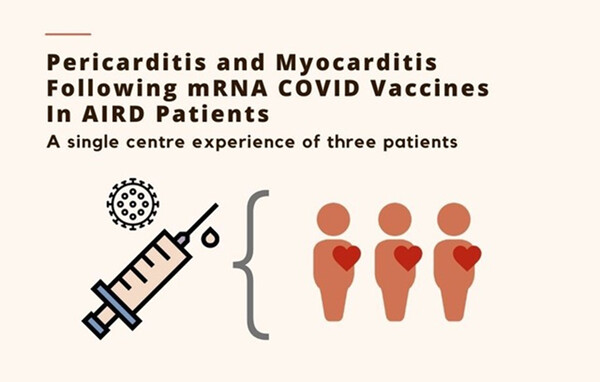
We present three AIRD patients who developed myocarditis or pericarditis approximately seven days after receiving their first dose of the Pfizer-BioNTech vaccine. All patients made full recovery following a course of prednisolone. This report highlights what we know about the risk of myocarditis or pericarditis following mRNA COVID-19 vaccines and the potentially increased risk in AIRD patients.
Key points
-
Myocarditis and pericarditis are recognized side effects of the messenger RNA (mRNA) vaccines Comirnaty (Pfizer/BioNTech) and Spikevax (Moderna).
-
Our observations support the theory that patients with autoimmune inflammatory rheumatic diseases that predisposes them to develop myocarditis/pericarditis, might put them at increased risk of developing this complication after the mRNA vaccine.
Open accessPerceptions into causes and consequences of severe acute respiratory syndrome coronavirus 2 (SARS‐CoV‐2) variants
Graphical Abstract
Highlights
-
The molecular mechanisms involved in viral evolution are enlightened. Such information will help to better understand the root causes for the emergence of severe acute respiratory syndrome coronavirus 2 (SARS-CoV-2) variants, their pathophysiology, and the mechanism(s) of infection.
-
Precision medicine-based strategies may help to eliminate and/or minimize the onset of future aftermaths of SARS-CoV-2 infections and their deleterious effects.
-
Ultimately, such efforts may pave the way for developing better vaccines and therapeutic regimens to control and/or prevent SARS-CoV-2 infections as well as the onset of associated autoimmune and other diseases in susceptible individuals.
Open accessImmunosuppressive therapy selectively modulates B‐cell responses in patients with rheumatic and musculoskeletal diseases receiving the inactivated COVID‐19 vaccine
Rui Li, Ruru Guo, Jia Li, Bing Zheng, Ronghao Xu, Xiaoyue Jiang, Yingying Chen, Guo Tang, Qianqian Li, Yixuan Li, Jiaqi Feng, Xiaoxiang Chen, Ying Wang, Shuang Ye, Fang Du, Liangjing Lu, Jun Deng,Graphical Abstract
Key points
-
Immunosuppressive treatment reduced the immunogenicity of the inactivated COVID-19 vaccine without increasing autoantibody titers or the flare rate in patients with rheumatic and musculoskeletal diseases (RMDs).
-
Immunosuppressive therapy selectively increased CD19+IgG−IgG1+ cells and decreased CD19+CD27+IgG+ and CD19+IgG+IgG1+ B cells, but not CD4+ T-cell subsets in RMD patients.
-
- Open access
IL‐21 regulates macrophage activation in human monocytic THP‐1‐derived macrophages
Graphical Abstract
Highlights
-
IL-21R is expressed in human monocytic THP-1 derived macrophages.
-
IL-21 up-regulates the gene expression and protein secretion of TNF-α, IL-6, and IL-10 in LPS-mediated THP-1 derived macrophages.
-
IL-21 plays a two-way regulatory role in THP-1 derived macrophage polarization.
Open accessOld and new damage‐associated molecular patterns (DAMPs) in autoimmune diseases
Graphical Abstract
Key points
-
The mevalonate pathway plays a major role in autoimmune diseases resulting from dysregulated inflammation.
-
Isoprenoid metabolites from the mevalonate pathway show that farnesyl pyrophosphate and geranylgeranyl pyrophosphate are new damage-associated molecular patterns (DAMPs).
-
Comprehensive analysis of isoprenoid metabolites derived DAMPs may lead to new treatments for autoimmune diseases.
-
Immune dysfunction contributes to the pathology of cross-sectional DAMPs in autoimmune diseases.
Open accessTh17/Treg balance and factors related to autoimmune hepatitis
Key points
-
Different liver damage caused by different modeling types will further explain the role of Th17/Treg imbalance in autoimmune hepatitis, and this imbalance has important implications for changes in immune status and disease progression.
-
In this study, α-galactosylceramide was used to establish the autoimmune hepatitis model, which shows similar pathological manifestations as that in human autoimmune hepatitis.
Open accessOrigins and history of autoimmunity—A brief review
Key points
-
Paul Ehrlich coined the term “horror autotoxicus” for autoimmunity and emphasized how the immune system distinguishes foreign from self.
-
The discoveries of allergy and anaphylaxis were the first signs that the immune system was capable of self-damage. The studies on chronic thyroiditis and clinical laboratory breakthroughs led to the acceptance of autoimmune disease in the 1950s.
-
The first autoantibodies were discovered in the 1940s when antinuclear antibodies and rheumatoid factors were recognized as the diagnostic features of systemic lupus erythematosus and rheumatoid arthritis, respectively.
-
Frank Macfarlane Burnet founded the science of autoimmunity and developed the clonal selection theory of forbidden clones.
-
Autoantibodies play a vital role in the pathogenesis of autoimmune diseases and are responsible for systemic inflammation and tissue injury.
Open accessAcute kidney injury following autoimmune hemolytic anemia due to simultaneous use of ciprofloxacin and hydrochlorothiazide: A case report and review of the literature
Graphical Abstract
Highlights
-
The combination of hemolytic anemia and acute kidney injury following the concomitant use of ciprofloxacin and hydrochlorothiazide is a rare and severe complication presented in this study.
-
Healthcare providers should be aware of the life-threatening drug-induced autoimmune hemolytic anemia that may occur with commonly used drugs.
-
The treatment mainly includes cessation of the offending drug, steroid therapy, blood transfusion if needed, and supportive care.
-
- Open access
Association of immunoglobulin G4‐related disease with a family history of malignancy: A retrospective study of 168 cases
Key points
-
Immunoglobulin G4-related disease (IgG4-RD) is a systemic immune-mediated fibroinflammatory condition. Previous studies have indicated relationships between malignancy and autoimmunity.
-
This retrospective cohort study found that a family history of malignancy was present in 13.1% of IgG4-RD patients.
-
Family history of malignancy may be associated with IgG4-RD development and genetic susceptibility may be involved in the pathogenesis of IgG4-RD, but further studies are needed to test this hypothesis and explore possible susceptibility genes.
Open accessBiliary candidiasis mimicking IgG4‐related disease in a patient with normal immunity
Wenjie Bian, Yuchao Zhong, Xia Zhang, Hongbin Chen, Ruie Feng, Xinyu Zhang, Danhua Shen, Yanying Liu,Graphical Abstract
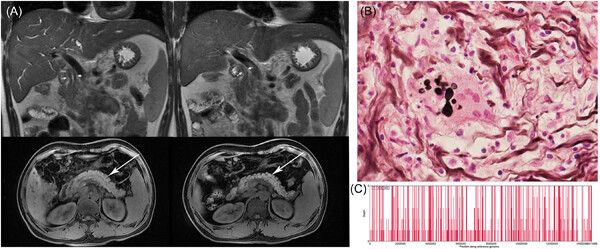
Imaging, pathological, and the second generation sequencing evidence of Candida albicans. (A) Abdominal magnetic resonance imaging before and after treatment. Upper left: Markedly thickened biliary duct wall and luminal stenosis. Lower left: A swollen pancreas, especially in the head region, with a dilated pancreatic duct. Upper right: Alleviation of the disease by bile duct stenosis. Lower right: Alleviated pancreatic swelling. (B) Periodic acid-Schiff staining demonstrated multiple, narrow base, budding yeast cells. (C) The sequencing data indicative of Candida albicans. The abscissa represents the position in the C. albicans genome and the ordinate represents the sequence depth.
Key points
-
Biliary candidiasis could mimic IgG4-RD in a patient with normal immunity.
-
IgG4-RD should be diagnosed carefully especially in some rare cases.
Open accessHistological evolution of IgG4 related disease
-
- Open access
Inflammatory phenotype of osteoarthritis and its potential therapies
Highlights
-
This review summarize the major results of some emerging therapies targeting inflammatory phenotype in clinical trials, implying future directions for OA treatment.
-
This work provide a new perspective to develop true DMOADs that target the OA inflammatory phenotype.
-
- Open access
Protocol for a randomized controlled trial of electroacupuncture in the management of patients with axial spondyloarthritis in Singapore (E‐AcuSpA)
Warren Fong, Yu Heng Kwan, Su-An Quek, Ader Lim, Chiah Yuen Wong, Shin Yoong Chua, Hui Chin Tan, Clara Eng, Choy Tip Tan, Bao Qiang Dong, Youyi Huang, Chuen Seng Tan, Bee Choo Tai, Ting Hui Woon, Jie Kie Phang, Hwee Ling Koh, Ying Ying Leung, Julian Thumboo, Truls Østbye,Graphical Abstract
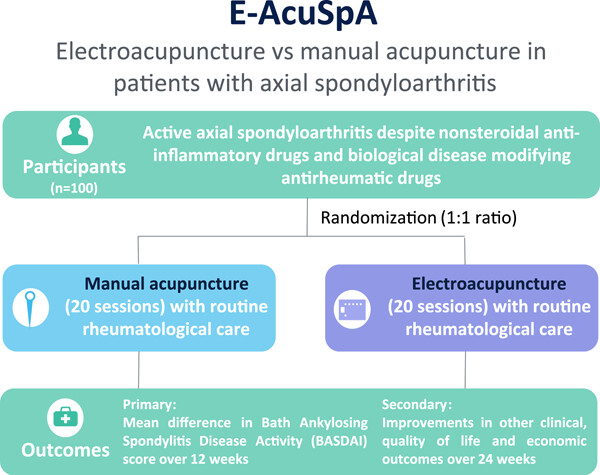
Graphical abstract of a randomized controlled trial comparing the efficacy of manual acupuncture and electroacupuncture for patients with axial spondyloarthritis. Primary outcome will be the mean difference in Bath Ankylosing Spondylitis Disease Activity (BASDAI) score over 12 weeks. Secondary outcomes will include improvements in other clinical, quality of life and economic outcomes over 24 weeks.
Highlights
-
There are currently a lack of randomised controlled trials comparing the efficacy between manual acupuncture and electroacupuncture.
-
This is a protocol for a randomised controlled trial comparing the efficacy between manual and electroacupuncture in patients with axial spondyloarthritis with inadequate response to conventional western medications.
-
The mean difference in Bath Ankylosing Spondylitis Disease Activity Index (BASDAI) score between the two groups over 12 weeks will serve as the primary outcome.
Open accessDepression in patients with ankylosing spondylitis
Key points
-
The risk of depression is higher in ankylosing spondylitis (AS) patients than in the general population.
-
Depressive symptoms in AS patients may be caused by the psychological stress, physical damage associated, and immune inflammation.
-
Treatment with cytokine inhibitors (including tumor necrosis factor-α, interleukin-17, and Janus kinase inhibitors) can improve clinical depression symptoms.
Open accessHuman leukocyte antigen B polymorphism and association between HLA‐B27 and endoplasmic reticulum aminopeptidase 1 rs30187 SNP in patients with ankylosing spondylitis in Bangladesh
Md Kamrul H. Sajib, Shamim Ahmed, Syed A. Haq, Minhaj R. Choudhury, Mohammed Uddin, Furkan Uddin, Muhammad S. A. Khan, Mohammad M. Zaman,Key points
-
HLA-B27 was more frequently found in AS patients (60.4%) than in controls (8.3%).
-
The combination of HLA-B27 and HLA-B60 was only found in AS patients.
-
No association between ERAP1 SNP rs30187 and HLA-B27 was observed in Bangladeshi AS patients.
-
First HLA-B27 association in Bangladesh.
-
Limitation: Single tertiary level hospital-based study.
-
- Open access
Effect of lymphotoxin blockage on different stages of Sjogren's syndrome in an animal model
Key point
Blocking lymphotoxin in an animal model of Sjogren's syndrome in shown to block disease progression when used at both early and later disease stages.
Open accessExploring salivary biomarkers and swallowing perceptions in Sjogren's syndrome: A case–control feasibility study
Veronica H. Letawsky, Parker J. Holman, Caroline T. Nguyen, Camilla Dawson, Joanne Weinberg, Lynne J. Williams, Stacey A. Skoretz,Graphical Abstract
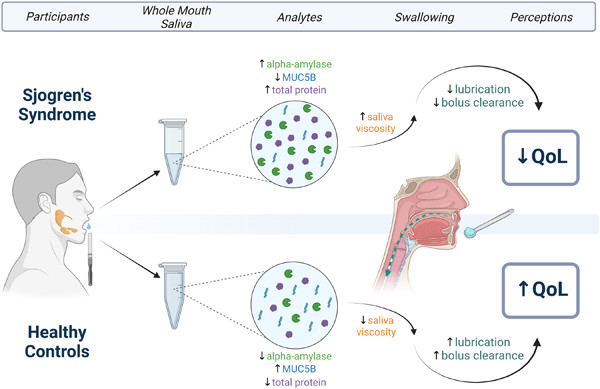
We distinguished novel relationships between salivary properties and participant-reported perceptions of swallowing in those with and without Sjogren's syndrome. Our findings support the feasibility of further study of saliva's role and analytes with lubricative properties during swallowing. Utilizing salivary investigations along with other swallowing diagnostics, salivary analyte profiling may enable biomarker-based diagnostic and treatment approaches for dysphagia and autoimmune diseases.
Key points
-
Our successful feasibility study distinguished individuals with and without Sjogren's syndrome (SS) according to novel relationships between salivary properties and participant-reported perceptions of swallowing.
-
Salivary analyte profiling in SS may enable biomarker-based approaches to early identification, differential diagnosis, and bespoke treatment of dysphagia, while also informing the diagnostic process for SS and other chronic, autoimmune conditions.
Open accessAmyloidosis with recurrent oral and peptic ulcers mimicking Behcet's syndrome: A case report
Graphical Abstract
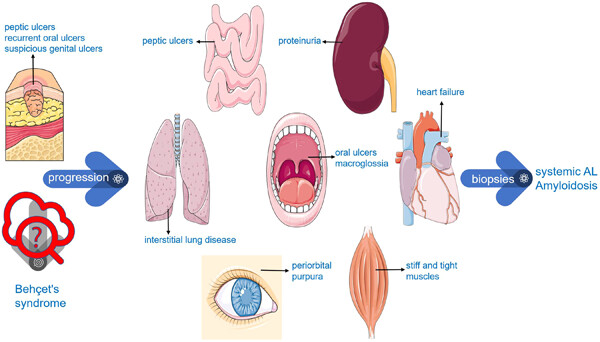
We report a case of a 43-year-old woman who initially presented with peptic ulcers, recurrent oral ulcers, and suspicious genital ulcers resembling Behcet's syndrome. Her symptoms were not relieved by systemic steroids and gradually presented multiple system damage involving kidney, heart, lung, skin, and mucous membranes. She was diagnosed with systemic immunoglobulin light chain (AL) amyloidosis after three biopsies.
Key points
-
Sometimes amyloidosis mimics Behcet's syndrome (BS).
-
When the patient's symptoms can not be relieved by systemic steroids, rheumatologists should reconfirm the diagnosis of BS.
-
When the diagnosis is unclear, multiple biopsies are required.
Open accessIdentification and functional analysis of shared gene signatures between systemic lupus erythematosus and Sjögren's syndrome
Graphical Abstract

Thirty-two shared differential expressed genes (DEGs) were screened in systemic lupus erythematosus and Sjögren's syndrome transcriptome data sets. These 32 shared DEGs were mainly enrichment in biological progress associated with type I interferon signaling pathway, defense response to virus, response to virus, negative regulation of viral genome replication, and immune response.
Key points
-
Two hundred and thirty-two and 110 differentially expressed genes (DEGs) were screened in systemic lupus erythematosus (SLE) and primary Sjögren's syndrome (pSS) peripheral blood mononuclear cells RNA-seq data sets, respectively.
-
Thirty-two shared DEGs were screened in SLE and pSS data sets, which were all upregulated in patients compared to controls.
-
These 32 shared DEGs were mainly enrichment in biological progress associated with type I interferon signaling pathway, defense response to virus, response to virus, negative regulation of viral genome replication, and immune response.
Open accessA case of Sjogren's syndrome evolving into multicentric reticulohistiocytosis
Daniel Gonzalez, Vinh Lu, Madeline Bonnet, Rachelle Gietzen, Anthony Linfante, Enrique Medina, Vijaya Murthy,Graphical Abstract
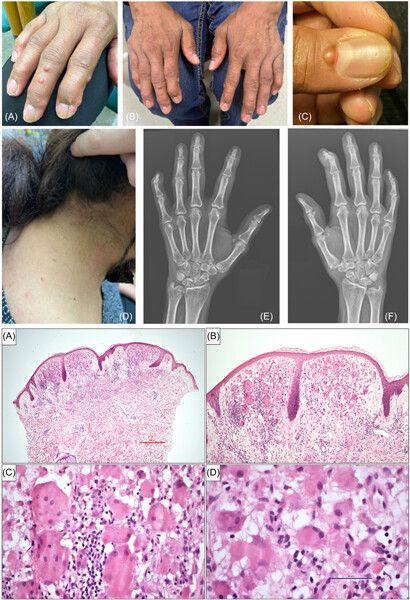
We herein present a 53-year-old female patient who had been previously diagnosed with Sjogren's syndrome many years prior who later developed multicentric reticulohistiocytosis (MRH). There were several small, papulo-nodular lesions ranging from 1 to 2 mm in size noted at the base of her nails. A 4 mm punch biopsy of one of the papules from the neck showed dermal infiltration of eosinophilic mononucleated and multinucleated giant cells with “ground glass” appearing cytoplasm consistent with MRH. X-ray of her hands showed periarticular demineralization and erosions surrounding several bilateral proximal and distal interphalangeal joints, and thus tofacitinib in addition to methotrexate, hydroxychloroquine, and dexamethasone (dosed weekly) was started to help control any further articular damage.
Key points
-
Multicentric reticulohistiocytosis (MRH) is a rare, multisystemic disease that can be distinctly characterized by the presence of papulonodular lesions appearing over the distal fingers and periungual area, typically described as having a “coral beads” pattern.
-
There are no diagnostic laboratory tests for MRH, although the diagnosis is typically made by the presence of the pathognomonic papulonodular lesions with aggressive erosive arthritis seen predominantly in the distal interphalangeal joints, as well as a skin and/or synovial biopsy.
-
Methotrexate has been considered as the most effective initial disease-modifying antirheumatic drug to use, although other options have also shown success including leflunomide, azathioprine, tumor necrosis factor inhibitors, thalidomide, interleukin (IL)-6 inhibitors, and IL-1 inhibitors.
-
- Open access
Anti‐Jo1 autoantibodies, from clinic to the bench
Key points
-
Clinical manifestations associated with the presence of anti-Jo1 autoantibodies and how the levels of autoantibodies correlate with disease activity.
-
Molecular characteristics of autoantibodies and their effects on immune cells to understand the contribution of autoantibodies and autoantigen to disease pathogenesis.
Open accessPhenotypical statin‐associated immune‐mediated necrotizing myositis with histological features of inclusion body myositis
Graphical Abstract
Key points
-
Statin-associated immune-mediated necrotizing myositis is a rare but important complication of statin use to recognize.
-
Statin-associated immune-mediated necrotizing myositis and inclusion body myositis can present with unique clinical and pathological features.
-
Statin-associated immune-mediated necrotizing myositis may improve with statin cessation and various immunosuppressive therapy while inclusion body myositis is typically refractory to therapy.
Open accessHigh‐throughput transcriptomic profiling of mRNAs and lncRNAs in the dermatomyositis muscle by RNA sequencing
Graphical Abstract
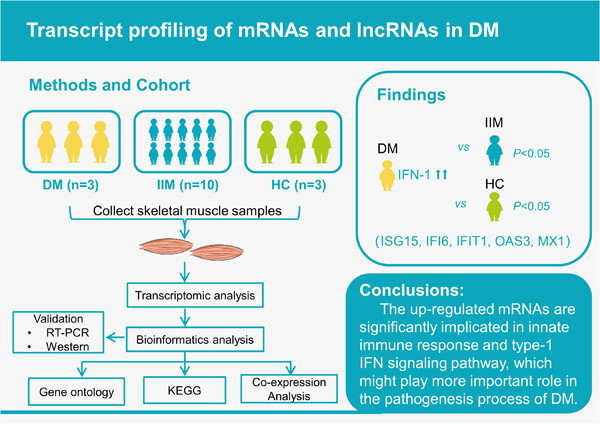
Three dermatomyositis (DM) patients, 10 idiopathic inflammatory myopathy (IIM) patients, and three healthy controls were included for this study to collect skeleton muscle biopsy samples. Then, transcriptomic analysis and reverse transcription polymerase chain reaction were performed to determine differentially expressed mRNAs and long noncoding RNAs between them. Bioinformatics analyses, including gene ontology, Kyoto Encyclopedia of genes and genomes, and co-expression analysis, were employed to characterize the biological process and signaling pathway. Finally, we found that ISG15, IFI6, IFIT1, OAS3, and MX1, five type-I interferon (IFN) associated genes, were significantly upregulated in DM muscle tissues, which indicated that the type-I IFN signaling pathway might play a more important role in the pathogenesis process of DM.
Key points
-
Compared with healthy controls, 372 differentially expressed mRNAs were identified within the dermatomyositis group by performing RNA-sequencing, including 275 upregulated and 97 downregulated ones.
-
Overall, 692 differentially expressed long noncoding RNAs were identified in the dermatomyositis group compared with healthy controls, of which 407 were upregulated and 285 were downregulated.
-
ISG15, IFI6, IFIT1, OAS3, and MX1, five type-I interferon-stimulated genes were found to be significantly upregulated in dermatomyositis muscle tissues compared with the levels in healthy control tissues.
-
- Open access
Efficacy of telitacicept in patients with lupus‐ and antiphospholipid syndrome‐associated refractory thrombocytopenia
Graphical Abstract

Efficacy of telitacicept in patients with lupus- and antiphospholipid syndrome-associated refractory thrombocytopenia. aCL, anticardiolipin antibody; aβ2-GPI, anti-beta2-glycoprotein I; CsA, cyclosporin A; HCQ, hydroxychloroquine; LA, lupus anticoagulant; LD-IL-2, low-dose interleukin-2; MMF, mycophenolate mofetil; RTX, rituximab.
Key points
Telitacicept may be a safe and effective treatment for refractory thrombocytopenia in lupus and antiphospholipid syndrome patients.
Open accessRole of β2‐glycoprotein I in the pathogenesis of the antiphospholipid syndrome
Graphical Abstract
Key points
-
Antiphospholipid syndrome (APS) is a life-threatening disease characterized by increased antiphospholipid antibodies.
-
The pathogenesis of β2-glycoprotein I (β2GPI)-related APS involves inflammation, coagulation, complement cascade, and endothelial function disorder.
-
β2GPI is a plasma glycoprotein consisting of DI–DV domains and exerts various functions through changing structure conformation.
-
- Open access
Severe IgA vasculitis with features of remitting seronegative symmetrical synovitis with pitting edema (RS3PE) syndrome in a 60‐year‐old male treated with plasmapheresis
Highlights
- Possible association between systemic IgA vasculitis and RS3PE syndrome.
- Adults with IgA vasculitis with renal involvement need to be treated aggressively.
- IgA vasculitis with renal involvement acutely resolved with high-dose glucocorticoids and plasmapheresis.
- Open access
Associations of autoantibodies and clinical profile of the patients with systemic sclerosis
Shahin Mahmud, Minhaj R. Choudhury, Iftekhar H. Bandhan, Md. Sahidul Islam, Md. Abu Shahin, Syed A. Haq, Mohammad M. Zaman,Key points
-
Anti-topoisomerase-I was the most prevalent autoantibody in patients with systemic sclerosis in Bangladesh.
-
Coexistence of antiribonucleic acid polymerase-III and anti-U1-ribonucleoprotein was a common finding.
-
Antiribonucleic acid polymerase-III antibody and anti-U1-ribonucleoprotein had significant associations with pulmonary arterial hypertension and restrictive lung disease, respectively.
Open accessCauses and predictors of mortality in South Africans with systemic sclerosis
Graphical Abstract
Key points
-
Systemic sclerosis carries a poor prognosis in South African systemic sclerosis patients and an estimated overall 5-year survival rate of 58%.
-
Cardiorespiratory complications of interstitial lung disease with or without pulmonary hypertension were the most common cause of death.
-
Cor pulmonale and renal dysfunction were independent predictors of death.
-
- Open access
New and emerging therapies in gout
Key points
-
Extensive research is happening in the field of gout therapy resulting in the arrival of newer, more effective drugs.
-
Interleukin-1 (IL-1) inhibitors, inflammasome inhibitors, and caspase inhibitors have upsurged as effective anti-inflammatory agents in gout.
-
Urate transporter-1 (URAT-1) inhibitors, adenosine triphosphate-binding cassette transporter G 2 (ABCG2) activators, and newer Xanthine oxidase inhibitors have been added to our armamentarium against gout.
-
Discovery of the hypouricemic potential of common drugs such as atorvastatin, amlodipine, losartan, and fenofibrate has led to more options for the control of gout in people with comorbidities.
Open accessConstruction of an easy‐to‐use predictive model for ultrasound‐detected tophi to improve the detection of hidden tophi
Wei Liu, Wen Guo, Kaiping Zhao, Qiang Zang, Husheng Wu, Siliang Man, Hongchao Li, Liang Zhang, Hui Song,Graphical Abstract
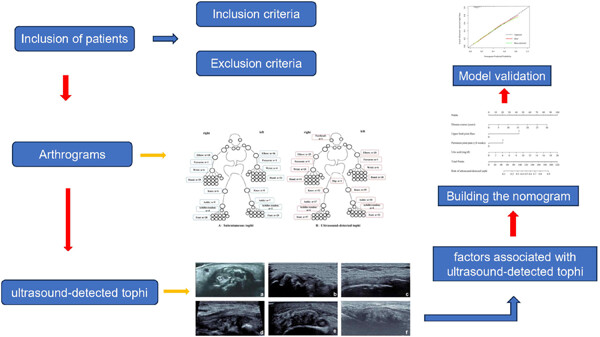
Five hundred and seventeen gout patients were included in the study after screening on the basis of inclusion and exclusion criteria. A contrast map of visually detected tophi versus ultrasound-detected tophi is presented. Typical ultrasound-detected tophi are presented. Univariate and multivariate analyses were used to analyze the independent correlation factors with tophi explored by ultrasound, and a nomogram was subsequently established. Finally, the validity of the model was verified.
Key points
-
Ultrasound detects almost twice as many tophi as rheumatologists observe visually.
-
Some readily available clinical indicators can predict the presence of hidden tophi.
-
An easy-to-use clinical prediction model was developed to facilitate the discovery of hidden tophi.
-
- Open access
Bullous eruption as a cutaneous manifestation of eosinophilic granulomatosis with polyangiitis
Graphical Abstract
Key points
-
Bullous eruption is a rare cutaneous manifestation of EGPA.
-
The heightened awareness and prompt recognition of the cutaneous manifestations are crucial for the early diagnosis of EGPA.
Open accessLingual Raynaud's phenomenon in a patient with mixed connective tissue disease
Graphical Abstract
Key points
-
Raynaud's phenomenon may occur as a primary problem or secondary to an autoimmune disease such as scleroderma, mixed connective tissue disease, SLE, or Sjogren's.
-
Lingual Raynaud's is rare, but it is important to recognize as it is often attributed to autoimmune disease.
-
There is a wide range of symptoms in lingual Raynaud's from asymptomatic to severe, throbbing pain. Meticulous history taking is essential.
Open accessInflammatory bowel disease‐related periostosis
Graphical Abstract
Key point
-
Periosteal reaction and bone absorption could be manifested in ulcerative colitis.
Open accessAzathioprine‐induced pancytopenia: A case report
Keshav Raj Sigdel, Astha Thapa, Agnimshwor Dahal, Ramchandra Panthi, Krishan Adhikari, Pradeep Shrestha, Mipsang Lama, Buddhi Poudyal, Buddha Basnyat,Graphical Abstract
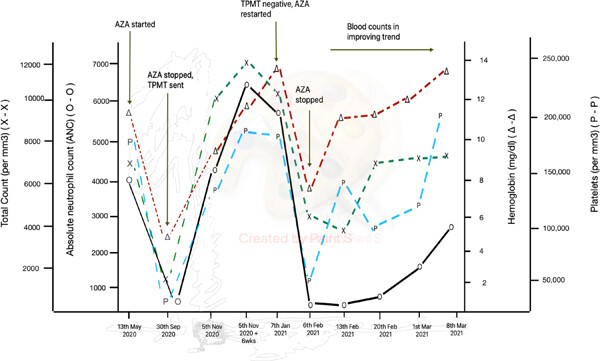
We report a case of severe myelosuppression following azathioprine (AZA) therapy in a 15-year-old female despite a normal thiopurine methyltransferase (TPMT) genotype. In patients with systemic lupus erythematosus (SLE), the distinction between disease-related and drug-induced myelosuppression is often difficult. Given the sequential relationship of AZA initiation with myelosuppression and its withdrawal with recovery, AZA-induced myelosuppression seemed a reasonable explanation in our patient's case. This report highlights the importance of regular complete blood count monitoring in patients receiving AZA therapy despite their TPMT levels.
Key points
-
Azathioprine-induced myelosuppression can occur in patients with normal thiopurine methyltransferase (TPMT) activity.
-
Total cell counts should be evaluated on a frequent basis after initiating azathioprine even in patients with normal TMPT activity.
Open accessPrevalence and pattern of soft‐tissue rheumatism in a rural community in South‐South Nigeria: A cross‐sectional survey
Key points
-
The prevalence of soft tissue rheumatism in rural Nigeria is 11.0%.
-
The commonest soft tissue rheumatic disorder found is adhesive capsulitis.
-
Age, sex, and dyslipidemia have a significant association with soft tissue rheumatism.
-
This study attempts to bridge the knowledge gap about soft tissue rheumatism in Nigeria due to the paucity of data, especially in rural regions.
Open accessTransient positive antimitochondrial M2 in sera of patients with connective tissue diseases after intravenous immunoglobulin infusions
Lijuan Yang, Xiuning Wei, Qianhua Li, Honggui Li, Zhiming Ouyang, Aiqi Zeng, Donghui Zheng, Lie Dai, Yingqian Mo,Graphical Abstract
Key points
-
High-titer antimitochondrial M2 (AMA-M2) autoantibodies were present in immunoglobulin preparations.
-
The AMA-M2 autoantibodies were transferred transiently into the circulation of patients with connective tissue diseases via intravenous immunoglobulin (IVIG) therapy.
-
To avoid false clinical decisions based on postinfusion antibody titers, retesting 1–2 months after high-dose IVIG immunomodulatory treatment was recommended.
Open accessA novel plasminogen mutation in a child with hereditary periodic syndrome: A case report
Graphical Abstract
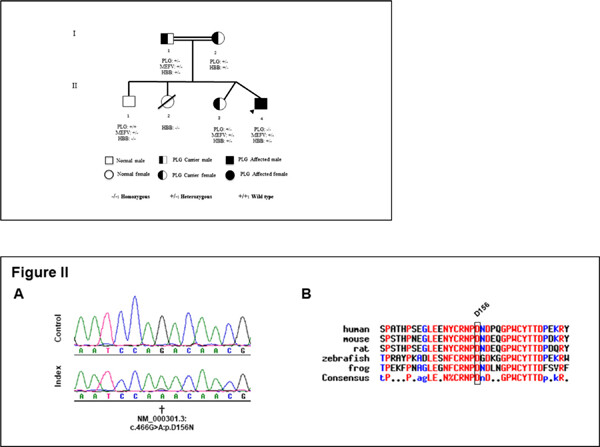
We present a child with recurrent fever. Genetic testing revealed a novel homozygous plasminogen (PLG) mutation and a likely benign heterozygous MEFV gene variant. We propose that the PLG mutation is responsible for the clinical manifestations, which may or may not be exacerbated by the coexistence of the MEFV variant. This report highlights the recently recognized role of the PLG pathway in inflammatory diseases and describes a potentially new presentation of PLG pathogenesis.
Highlights
-
Recently, plasminogen (PLG) has gained attention in inflammatory processes regulation.
-
This report highlights the recently recognized role of the PLG pathway in inflammatory diseases and describes a potentially new presentation of PLG pathogenesis.
Open accessLong‐term prognosis of focal segmental glomerulosclerosis treated with therapeutic low‐density lipoprotein‐apheresis in patients with severe kidney dysfunction and proteinuria
Shinji Kitajima, Megumi Osima, Hisayuki Ogura, Shiori Nakagawa, Yuta Yamamura, Taito Miyake, Taro Miyagawa, Tadashi Toyama, Akinori Hara, Norihiko Sakai, Miho Shimizu, Takashi Wada, Yasunori Iwata,Graphical Abstract
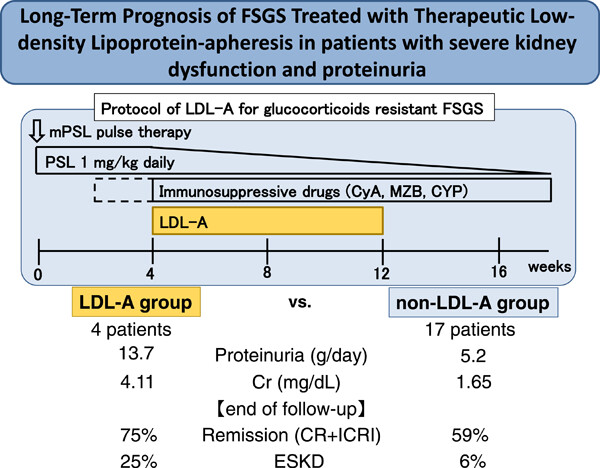
The prognosis of focal segmental glomerulosclerosis (FSGS) patients with nephrotic syndrome is poor. We investigated the effectiveness of treatment in 50 patients with primary FSGS. Low-density lipoprotein-apheresis (LDL-A) was performed in 4 patients who presented with steroid-resistant nephrotic syndrome. In comparison with 17 patients who did not receive LDL-A after 1989, the LDL-A group had higher urinary protein excretion (13.7 vs. 5.2 g/day, P = 0.053) and serum creatinine (4.11 vs. 1.65 mg/dL) levels at onset. Nevertheless, the LDL-A group showed a numerically higher remission rate (75% vs. 59%) compared with the nonlipoprotein-apheresis group.
Key points
The prognosis of focal segmental glomerulosclerosis (FSGS) patients with nephrotic syndrome is poor. We investigated the effectiveness of treatment in 50 patients with primary FSGS. Low-density lipoprotein-apheresis (LDL-A) was performed in four patients who presented with steroid-resistant nephrotic syndrome. LDL-A therapy tended to be chosen for more critical cases. Although it may be effective at improving the remission rate, we believe that studies on more patients are required to elucidate the effect on long-term prognosis.
Open accessMetagenomic next-generation sequencing for pneumocystis jirovecii pneumonia in patients with connective tissue disease
Graphical Abstract
Key points
-
There is a high mortality rate among CTD patients with PJP infection. Rapid and accurate diagnosis of PJP is important for successful treatment, but it remains challenging.
-
BALF mNGS technology is highly effective in diagnosing PJP in CTD patients.
-
BALF mNGS is a valuable diagnostic tool in these patients.
Open accessTreatment of STING‐associated vasculopathy with onset in infancy
KEY POINTS
-
The combination of low-dose cyclophosphamide (400 mg/m2), Tofacitinib and IVIG was effective and safe in the treatment of SAVI.
Open accessTargeted treatment strategy for patients with severe pulmonary hypertension secondary to connective tissue diseases
Graphical Abstract
Key points
-
This study showed that bosentan is more effective than sildenafil in the treatment of patients with severe pulmonary arterial hypertension associated with connective tissue diseases (CTD-PAH).
-
The findings are important for the clinical choice of targeted vasodilators for CTD-PAH.
-





